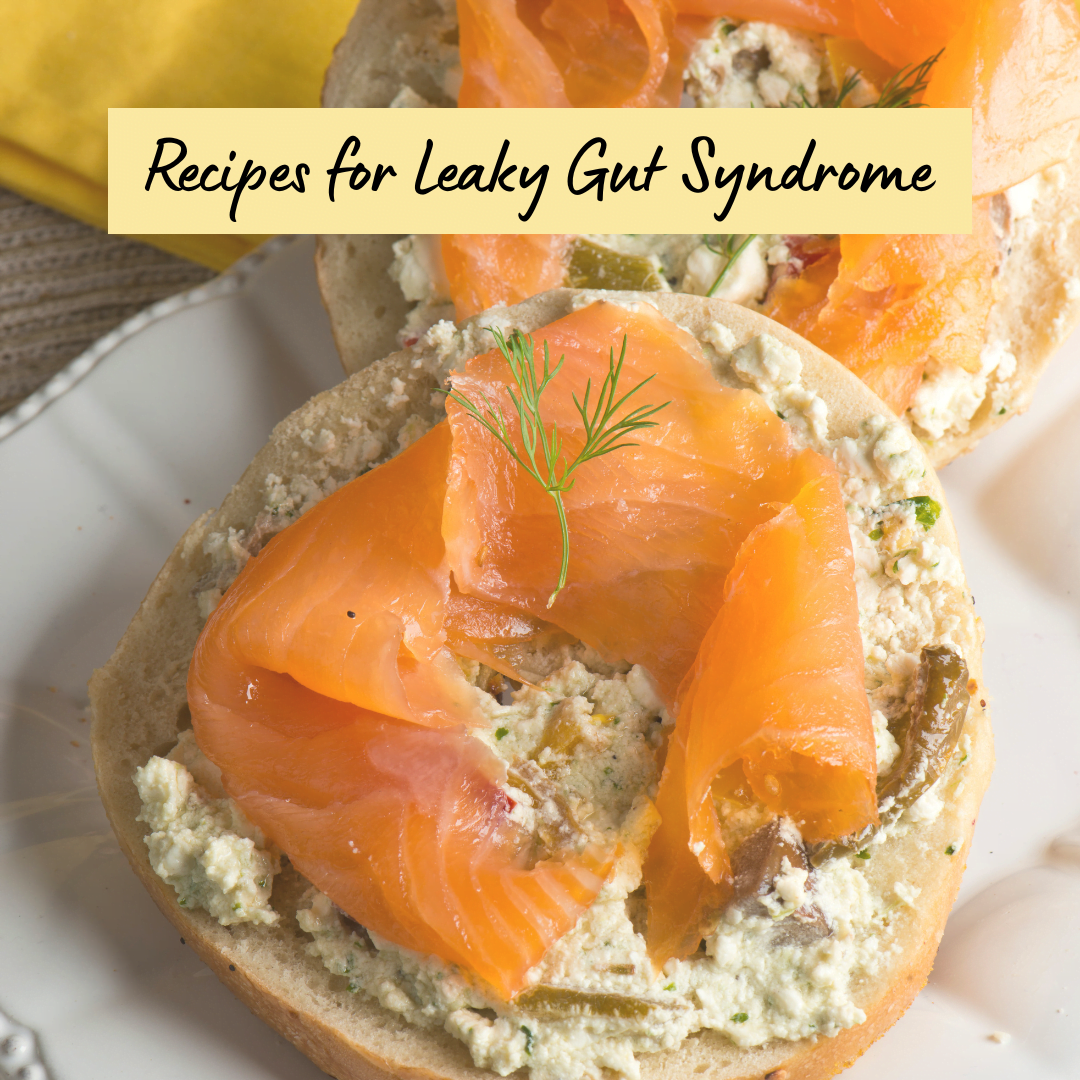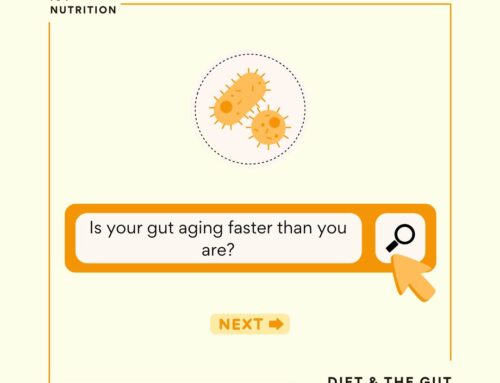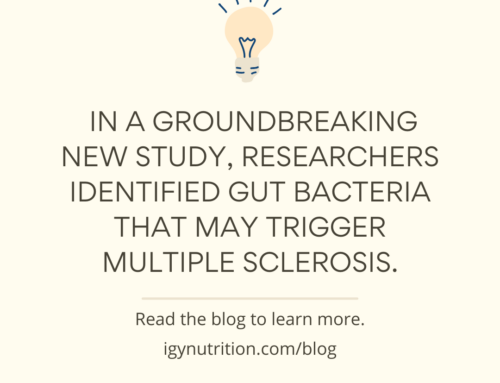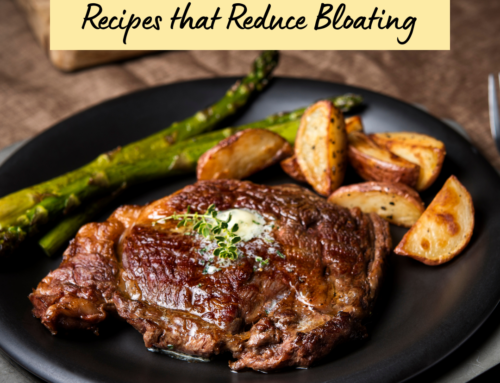Are you dealing with fatigue, brain fog, autoimmune conditions, and digestion issues? You might have “leaky gut” syndrome, which is characterized by a weak gut barrier.
Glutamine, omega 3, zinc, and vitamin D each help to fortify the gut barrier. Below, you’ll find recipes for leaky gut syndrome that are high in all four. Let’s get started!
Recap: What is the Gut Barrier?
The gut barrier is a lot like how it sounds. It’s a wall between your body and your intestines. In simple terms, it keeps what is meant to stay inside the gut inside it (1).
However, the gut barrier has to let some things from inside the gut into the rest of the body. Nutrients like vitamins, proteins, electrolytes, and water are great examples.
It must keep some things out of the body, too. Ideally, the barrier does not let pathogens and undigested food particles into the body – it should keep them in the gut so the body can get rid of them through stool.
The gut barrier lets only certain things through it. It’s like a bouncer – only those on the list can get in. This characteristic of the gut barrier is called selective permeability (2).
In cases of dysbiosis, excessive NSAID use, and inflammatory food and drink consumption, the gut barrier begins to weaken (3, 4, 5). The weaker it gets, the more porous it gets.
Increased permeability means that random things from inside the gut – those who aren’t on the list – may get by our bouncer, the gut barrier, and enter our bodies (1).
Overly permeable gut barriers may permit food particles and pathogens to enter our bloodstream and cause bodily damage. This condition is called leaky gut syndrome (1).
Some people with leaky gut syndrome experience intense fatigue, digestive symptoms, autoimmune diseases, and other conditions. Others are asymptomatic (1).
Whether you’re experiencing leaky gut syndrome or not, strengthening your gut barrier is a great way to improve gut and immune health (1) generally. Plus, preventing leaky gut down the line is an excellent investment.
So, how do we strengthen our gut barriers? Let’s take a look.
Glutamine and the Gut Barrier
If there is one piece of information you should take away from this blog, it’s that glutamine is your friend!
Glutamine is an amino acid that is shown to:
- Significantly strengthen gut barrier integrity (6)
- Diminish sugar cravings (7)
- Support healthy metabolisms (7)
Scientific evidence suggests that consuming over 5g of glutamine per day helps repair the gut lining (6).
Glutamine is found naturally in food. Meat like chicken and fish, vegetables like cabbage and spinach, and legumes like tofu, beans, and lentils are high in glutamine.
If you struggle with leaky gut syndrome, scientific evidence suggests that consuming over 5g of glutamine daily would help repair your gut lining (6). If you simply want to prevent leaky gut syndrome, 2-5g is a reasonable dose.
If you’re looking to pack an extra punch, many BCAA drinks contain high glutamine levels. Glutamine can also be added to drinks and smoothies, and it typically comes in powder form. Glutamine tastes pretty neutral, so there isn’t much to worry about when mixing it in beverages.
Vitamins and the Gut Barrier
Three vitamins are essential for gut barrier integrity: omega 3, zinc, and vitamin D.
Omega 3 vitamins are valuable for decreasing inflammation in the gut and improving microbiome composition, which are potential root causes of leaky gut syndrome (8, 9).
Omega 3 vitamins are found naturally in foods. Fish are the best source of omega-3 vitamins – they contain much higher amounts than vegetarian sources. Vegetarian sources include eggs, chia seeds, algae, walnuts, and flax seeds.
Most people are deficient in omega-3 vitamins. 1000 mg of omega-3 vitamins is the daily recommended dose. Supplementing with high-quality fish oil would greatly benefit your gut health if you struggle to include enough omega-3 vitamins in your diet.
Zinc is also incredibly valuable for immune and gut health. It is often recommended for those with colitis, Crohn’s disease, dysbiosis, SIBO, parasitic infections, or other gut issues because of its contribution to repairing the gut lining (10).
Zinc is found in beans, nuts, red meat, poultry, and dark leafy greens. Oysters are also incredibly high in zinc.
If you struggle to consume enough zinc in your diet, consider supplementing it. However, don’t go overboard – too much zinc can damage your gut lining. Aim for 8-11 mg per day.
Lastly, vitamin D is a crucial player. Some scientists believe a deficiency in vitamin D may even cause leaky gut syndrome – so ensuring you’ve enough vitamin D is key to overcoming the syndrome (11, 12).
Vitamin D gets a 5-star rating with gut health. Evidence asserts that it decreases inflammation, upregulates beneficial bacteria, improves food breakdown and absorption, and repairs gut lining.
Vitamin D can be found in fish, dairy, certain mushrooms, eggs, and fortified foods. If you’re vegetarian or vegan, consider supplementing with vitamin D since it’s hard to attain from plant sources.
Okay, so now we understand what it takes to build up our gut lining. How can we consume what’s needed in a healthy way? The recipes for leaky gut syndrome below contain all of the nutrients we talked about above. If you give them a shot, be sure to tag us in a photo of them on Instagram!
Supplemented Smoothie
Ingredients:
- 4 tbsp chia seeds
- 2 cups whole milk
- 1 cup kale
- 1 frozen banana
- ½ cup frozen berries
- 1 scoop glutamine powder (5g)
- 1 cup Greek yogurt
- 2 oz cashews
Directions:
- Put your milk, glutamine powder, and Greek yogurt in the blender and mix.
- Add your banana, berries, and kale. Blend. Then add your chia seeds and blend again.
- Top with your cashews and enjoy.
This smoothie contains:
- About 40% of your daily vitamin D needs
- 106% of your daily zinc needs if female, 77% if male
- 80% of your daily omega-3 needs
- 100% of your daily glutamine needs
Salmon Salad
Ingredients:
- 6 oz wild salmon
- 1 tbsp olive oil
- 1 cup kale
- 1 cup quinoa
- 1 avocado
- 1 tomato
- 2 oz cashews
Directions
- Cook your salmon in a pan on medium heat with olive oil.
- While it’s cooking, assemble your cooked quinoa and raw kale as the bed for your salad.
- Chop your tomato and cut your avocado. Add to the salad.
- When the salmon is fully cooked, add it to the salad. Top with cashews and enjoy.
Vitamin information:
- 112% of your daily zinc needs if female, 81% if male
- 100% of your daily vitamin D needs
- 50% of your daily omega-3 needs
- 100% of your daily glutamine needs
Bagel and Pudding Breakfast
Ingredients for bagel:
- Whole-grain bagel
- ¼ cup cream cheese
- 4 oz smoked salmon or lox
- 2 slices tomato
Ingredients for chia seed pudding:
- 4 tbsp chia seeds
- ½ cup whole milk
- 2 oz cashews
- ¼ blueberries
Directions:
- Mix your chia seeds with your milk. Cover and add to the refrigerator for at least two hours.
- Toast your bagel if you would like.
- Spread your cream cheese on top of your bagel.
- Add your tomato slices onto the cream cheese.
- Add your lox on top of each side. Close the sandwich.
- Take your chia seeds out of the refrigerator and mix them until smooth. Top with blueberries and cashews. Enjoy.
Vitamin information:
- 80% of daily omega-3 needs
- 95% of daily zinc needs if female, 70% if male
- 110% of daily vitamin D needs
- 100% of daily glutamine needs
Tag us in a photo of your favorite recipes for leaky gut syndrome on Instagram @igynutrition. Good luck on your digestive wellness journey!




